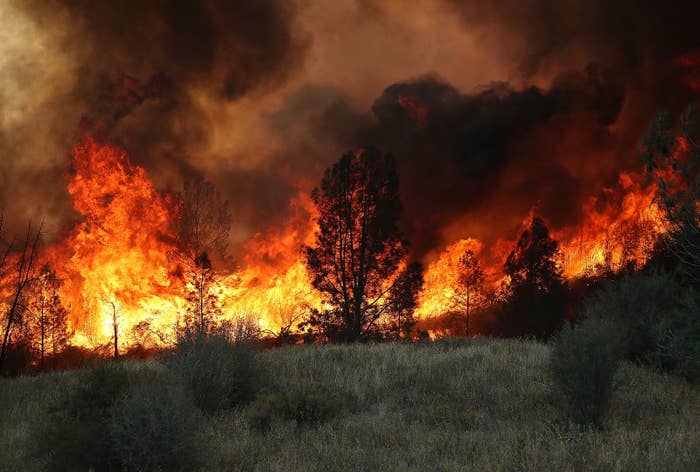
LOS ANGELES — As wildfires raged last week, Gov. Jerry Brown stepped up to a microphone, declared that "California's burning," and said climate change was to blame.
“You can imagine, if the drought continues for a year or several years, California could literally burn up," Brown added.
Then Friday, President Obama jumped on the bandwagon, saying that fires in the western U.S. are escalating and attributed that escalation to global warming.
At a glance, it looks like Brown and Obama are right. Data shows that as of Aug. 8, 117,960 acres have burned on state-managed land in California. That's more than twice the average for this time of year and when non-state land is factored in the number of charred acres jumps to well over 200,000 acres.

California's state firefighting agency, Cal Fire, agrees with Brown on the cause of the blazes.
"We attribute that to several things and the top being climate change," Cal Fire spokesperson Janet Upton told BuzzFeed News. She added that out of California's 20 largest fires since 1932, 12 have happened in just the last 13 years.
There's no doubt that California's fires are bad. However, a review of broader federal data shows that across the West the situation is not particularly unusual. In fact, certain fire-prone areas including California have actually had comparatively calm fire seasons so far in 2015.
The chart below shows the total number of acres burned in the U.S. through Aug. 11 of each year going back to 2005. This year, about 6.3 million acres have burned, which is a big jump from last year.
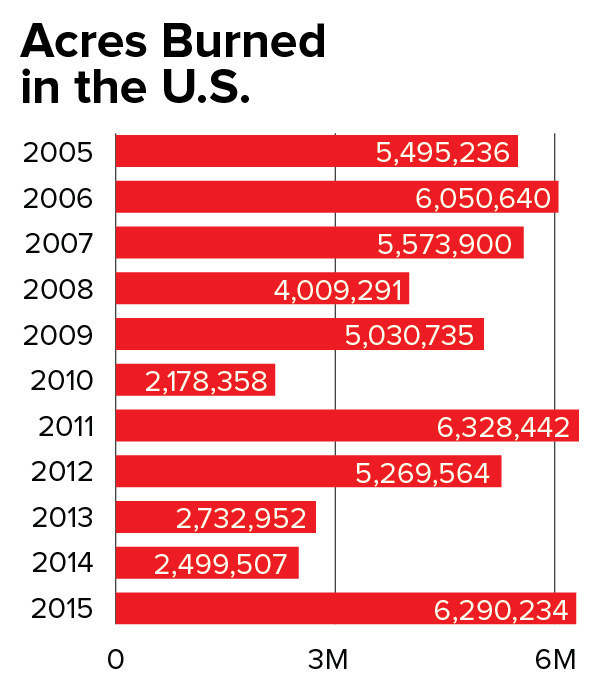
Compared to the past decade, however, this year's numbers look a lot more typical. Indeed, more than half of the last 10 years saw between 5 and 6 million acres burned by Aug. 11.
Moreover, about 85% of the acres burned this year in the U.S. have occurred in Alaska, which has seen a massive spike in fire activity. But due to their remote locations, the fires pose little threat to residents and are often allowed to burn.

National fire data paints an even more tranquil picture. So far this year there have been 38,917 wildfires, according to National Interagency Fire Center data. That's a small increase over the last two years by this time, but it's also fewer fires than every single other year since 2005.
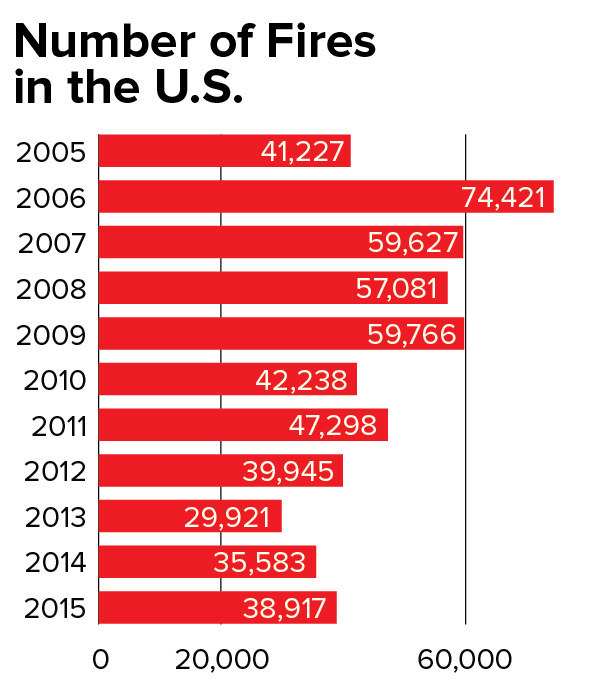
Regional data further shows that as of Aug. 12 in fire-prone Southern California, the total number of blazes is just slightly above average and still within "normal."
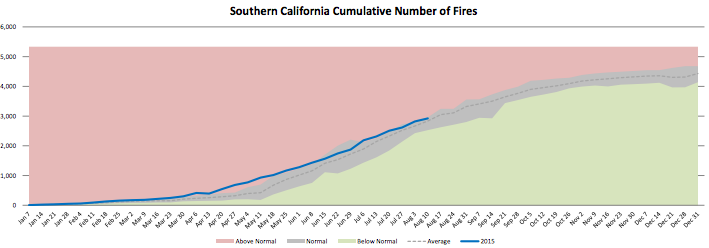
In the graph above, the blue line represents the total number of fires that have burned in 2015. The dotted line represents the 10-year average, while the gray area is what's considered "normal." The red and green regions represent above normal and below normal, respectively.
The number of acres burned so far in Southern California is actually below average.
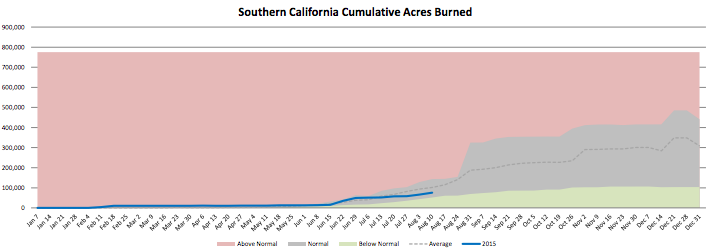
In Northern California — where a series of blazes have charred tens of thousands of acres in recent weeks — the situation is more dire. But only somewhat.

The graph above shows that in Northern California, the number of fires has been slightly above normal for most of the year.
However, the number of acres burned, represented below, stayed slightly below average for much of the year, then spiked at the end of July.
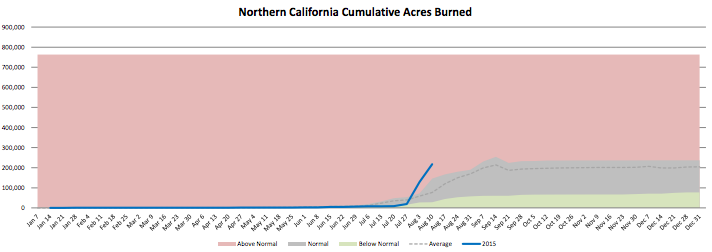
While this data does show that parts of California are burning, it reveals the West's fire situation is far less dire than elected officials have suggested.
"The Southwest has been fairly quiet. They didn’t really experience many fires this year"
In a conversation with BuzzFeed News, NIFC spokesperson Jessica Gardetto confirmed what the data seemed to be indicating: "We haven’t had that extreme of a fire season."
Up until recently, Gardetto explained, California specifically had been experiencing a calmer-than-normal fire season. Across the Southwest — which is experiencing a major drought — the number of fires and acres burned has remained below normal into the summer.
"The Southwest has been fairly quiet," she said. "They didn’t really experience many fires this year."
Asked if her organization attributed the current wildfire situation in the West to climate change, Gardetto said the issue is "still open to debate." Gardetto added that a growing El Niño, as well as fewer lightning strikes, have helped keep the number of fires down this year.
Bill Patzert, a climatologist at NASA’s Jet Propulsion Laboratory in Pasadena, told BuzzFeed News that climate change is a contributing factor to wildfires in the West, but not necessarily the biggest one.
"We want these forests to be 150 years old, but that’s not natural. And you’re setting yourself up for super fires."
"If I was to rank what's the biggest danger that we face from fires, I’d put people first, forest management second, and climate change third," Patzert said. "This Smokey the Bear bullshit where you put out every fire is not helpful."
The "Smokey the Bear" problem, as Patzert explained it, stems from the fact that forests are supposed to burn every 20 to 30 years. But when fires are extinguished via human intervention, fuel — in the form of dry brush and dead trees — turns into a massive tinderbox.
"We want these forests to be 150 years old, but that’s not natural," Patzert said. "And you’re setting yourself up for super-fires."
Patzert was not saying that climate change isn't a problem. Quite the opposite. But he was saying that huge blazes — and presumably the ones on the minds of political leaders who say that California could "literally" burn up — are as much the result of management decisions as they are of global warming.
Still, it sometimes seems like we're in the middle of a climate change-fueled wildfire apocalypse. One of the reasons for that might be because we're physically closer to the flames.
All of the experts who spoke to BuzzFeed News pointed out that one of the major challenges with wildfires in the U.S. is ongoing development along the border between cities and the wilderness — a space called the wildland-urban interface. That means firefighters end up working to extinguish blazes that might otherwise have been benign or beneficial.
"You have all these areas that historically have always burned, but now we’re building in those areas."
"If you look at the West, more and more people are moving into these wild land urban interfaces," Gardetto, who is based in Idaho, said. "So that’s creating more of these extreme situations where you could potentially lose more homes. Statistically, it's going to increase the likelihood of losing houses."
Patzert said this is in large part the root of the Smokey the Bear problem, because firefighters end up spending time, resources, and sometimes lives trying to save buildings.
"You have all these areas that historically have always burned," he said, "but now we’re building in those areas."
And with more people and homes in fire zones, the threat increases regardless of the absolute magnitude of the blazes themselves.

And while the wildfire activity is considered to be within the range of "normal" now, they're still quite severe.
"Starting with about the year 2000, we really started seeing these extreme fire seasons," Gardetto said. "Longer summers, higher temperatures, warmer winters in a lot of locations."
This is a longer-term trend — less "California is burning," and more "California (and more broadly the West) are generally becoming drier" — and it has an array of implications. Upton and Patzert both mentioned the cyclical problem of dying trees which then become fodder for wildfires. Letting forests freely burn also isn't a viable option, and not just because it would threaten homes.
"In 2013, the 257,000-acre Rim fire — the largest ever in the Sierra Nevada — released an estimated 11 million metric tons of greenhouse gases," Nancy Volger, of the California Natural Resources Agency, told BuzzFeed News in an email. "That’s roughly equivalent to the greenhouse gas emissions from 2.3 million cars."
Still, the data shows that while fire is prevalent — and perhaps more so than people in the West would like — it's not necessarily on the verge of "literally" burning up the entire region.
"The world is warming, the world is melting, sea level is rising," Patzert said. "But don’t blame everything on climate change."
